Performance Analysis of Acceleration and Inertial Force of Electromagnetic Suspension Inertial Stabilizer
Abstract
1. Introduction
2. Modeling and Mechanical Analysis of EMS Inertial Anti-Rolling Mass Block
2.1. Structural Diagram of EMS Inertia Stabilizer
2.2. Mechanical Analysis of Single Mass Block of EMS Inertia Stabilizer
2.3. Simulation of Single Mass Block of EMS Inertial Stabilizer
2.4. Mechanical Analysis of Double Mass Block of EMS Inertial Stabilizer
2.5. Double Mass Block Simulation of EMS Inertial Stabilizer
3. Influence of Nonlinear Factors on Performance of EMS Inertial Stabilizer
3.1. Theoretical Analysis and Simulation of Nonlinear Factors
3.2. Time Response Characteristic Tests of Nonlinear Factors
4. Tests and Results
4.1. Experiments
4.2. Comparison between Analytical Calculation, Numerical Results and Experimental Results
5. Conclusions
Author Contributions
Funding
Institutional Review Board Statement
Informed Consent Statement
Data Availability Statement
Conflicts of Interest
References
- Prasad, V.; Tiwari, R. Identification of Speed-dependent Active Magnetic Bearing Parameters and Rotor Balancing in High-speed Rotor Systems. J. Dyn. Syst. Meas. Control 2019, 141, 041013. [Google Scholar] [CrossRef]
- Chaowu, J.; Yili, Z.; Longxiang, X.; Lei, J.; Laishui, Z. Dynamics of Rotor Drop on New Type Catcher Bearing. Trans. Nanjing Univ. Aeronaut. Astronaut. 2014, 31, 70–77. [Google Scholar]
- Moreira, A.B.B.; Thouverez, F. Influence of Blade Flexibility on the Dynamic Response Simulation of a tur-bomolecular Pump on Magnetic Bearings. J. Eng. Gas Turbines Power 2020, 142, 041004. [Google Scholar] [CrossRef]
- Hawkins, L.; Prosser, D.; Filatov, A.; Prosser, D. Test Results and Analytical Predictions for Rotor Drop Testing of an Active Magnetic Bearing Expander/Generator. J. Eng. Gas Turbines Power 2007, 129, 522–529. [Google Scholar] [CrossRef][Green Version]
- Xing, M.; Wei, T. Autobalancing of High-speed Rotors Suspended by Magnetic Bearings Using LMS Adaptive Feedforward Compensation. J. Vib. Control 2014, 20, 1428–1436. [Google Scholar] [CrossRef]
- Cong, P.; Jinji, S.; Cunxiao, M.; Jiancheng, F. A novel Cross-feedback Notch Filter for Synchronous Vibration Suppression of an MSFW with Significant Gyroscopic effects. IEEE Trans. Ind. Electron. 2017, 64, 7181–7190. [Google Scholar]
- Sotelo, G.G.; de Andrade, R.; Dias, D.H.N.; Ferreira, A.C.; Costa, F.; Machado, O.J.; de Oliveira, R.A.H.; Santos, M.D.A.; Stephan, R.M. Tests with One Module of the Brazilian Maglev-cobra Vehicle. IEEE Trans. Appl. Supercond. 2013, 23, 3601204. [Google Scholar] [CrossRef]
- De Oliveira, R.A.H.; Stephan, R.M.; Ferreira, A.C. Optimized Linear Motor for Urban Superconducting Magnetic Levitation Vehicles. IEEE Trans. Appl. Supercond. 2020, 30, 1–8. [Google Scholar] [CrossRef]
- Takeshi, M.; Masaya, T.; Kishita, D.; Hirakawa, K. Vibration Isolation System Combining Zero-power Magnetic Suspension with Springs. Control. Eng. Pract. 2007, 15, 187–196. [Google Scholar]
- Carrella, A.; Brennan, M.J.; Waters, T.P.; Shin, K. On the Design of a High-static-low-dynamic Stiffness Isolator Using Linear Mechanical Springs and Magnets. J. Sound Vib. 2008, 315, 712–720. [Google Scholar] [CrossRef]
- Nan, Q.; Jun, Z.; Lei, W.; Wang, B.; Li, J.; Ren, Y.; Deng, Z. Dynamic Vibration Characteristics of HTS Levitation Systems Operating on a Permanent Magnet Guideway Test Line. IEEE Trans. Appl. Supercond. 2017, 27, 3601405. [Google Scholar]
- Wuyang, L.; Nan, Q.; Yu, R.; Yanxing, L.; Jun, Z.; Zigang, D. An Onboard Measurement System for Studying the Dynamic Running Characteristics of HTS Maglev. IEEE Trans. Appl. Supercond. 2018, 28, 3601005. [Google Scholar]
- Hoon, P.C.; Chang, P.H.; Cho, H.W.; Moon, S.J.; Chung, T.Y. Development of a Small Maglev-type Antirolling System. Rev. Sci. Instrum. 2010, 81, 056102. [Google Scholar]
- Hirakawa, Y.; Hirayama, T.; Kakizoe, K.; Takayama, T.; Funamizu, S.; Okada, N.; Yamane, A. Sea Trial of Prototype Vertical Weight Stabilizer (VWS) Anti-rolling System for Small Ships. J. Mar. Sci. Technol. 2014, 19, 292–301. [Google Scholar] [CrossRef]
- Gaoming, Q.; Hongyu, Q. The Invention Relates to a Marine Permanent Magnetic Levitation Anti-swing Automatic Balance System and Its Application. C.N. Patent 201810771460.2, 13 November 2018. [Google Scholar]
- Li, S.; Ding, F.; Zhang, D.; Shan, T.; Chi, B.; Bai, W.; Yang, W. Ship Moment Gyro Rolling Control Device and Rolling Control Method. C.N. Patent 201210480310.9, 16 November 2012. [Google Scholar]
- Sumei, G.; Quanyong, J.; Chaowu, J. Support characteristics and application of permanent magnet suspension active mass drive system. Int. J. Appl. Electromagn. Mech. 2021, 67, 83–96. [Google Scholar]
- Sumei, G.; Longxiang, X.; Chaowu, J.; Qianwei, C. Adaptive Magnetic Suspension Anti-rolling Device Based on Frequency Modulation. Open Phys. 2020, 18, 189–198. [Google Scholar]
- Yefa, H. Basic Theory and Application of Magnetic Bearing; China Machine Press: Beijing, China, 2006. [Google Scholar]
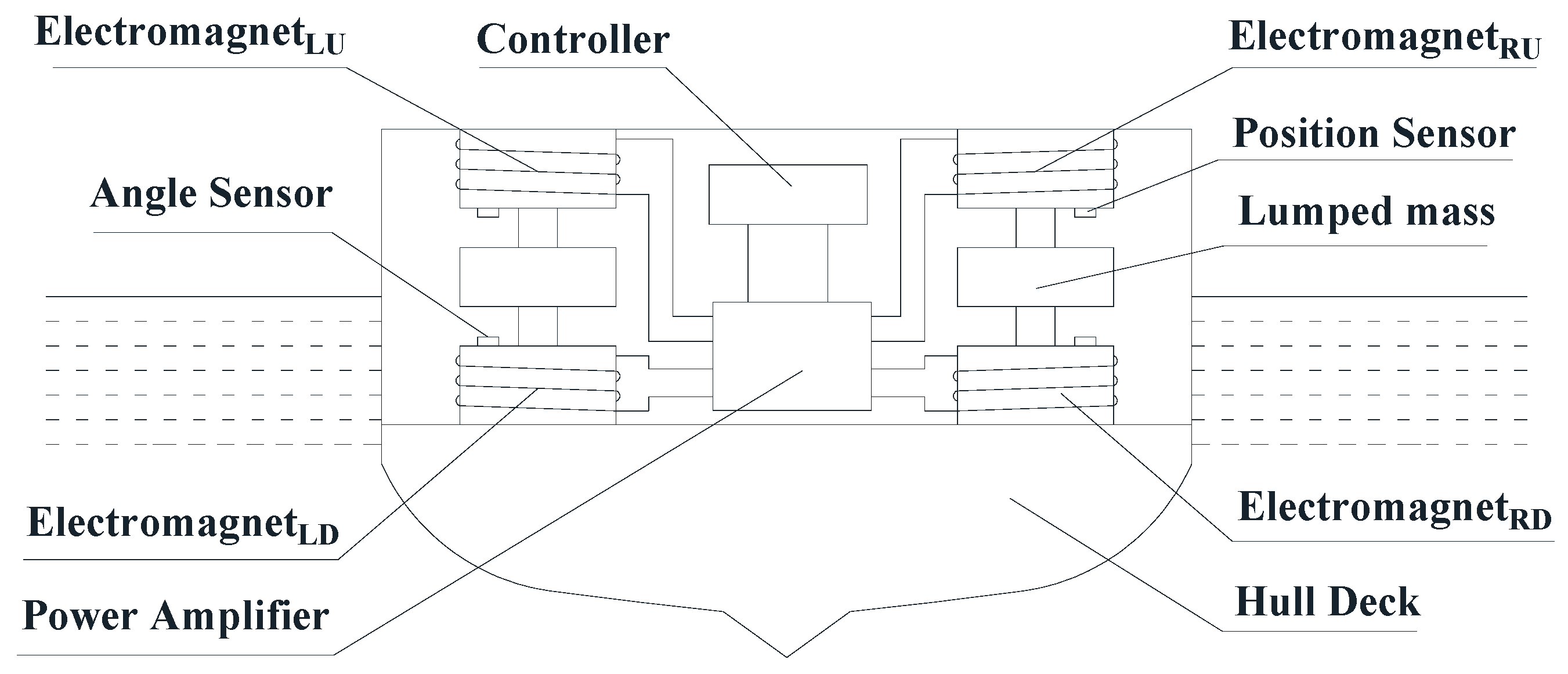


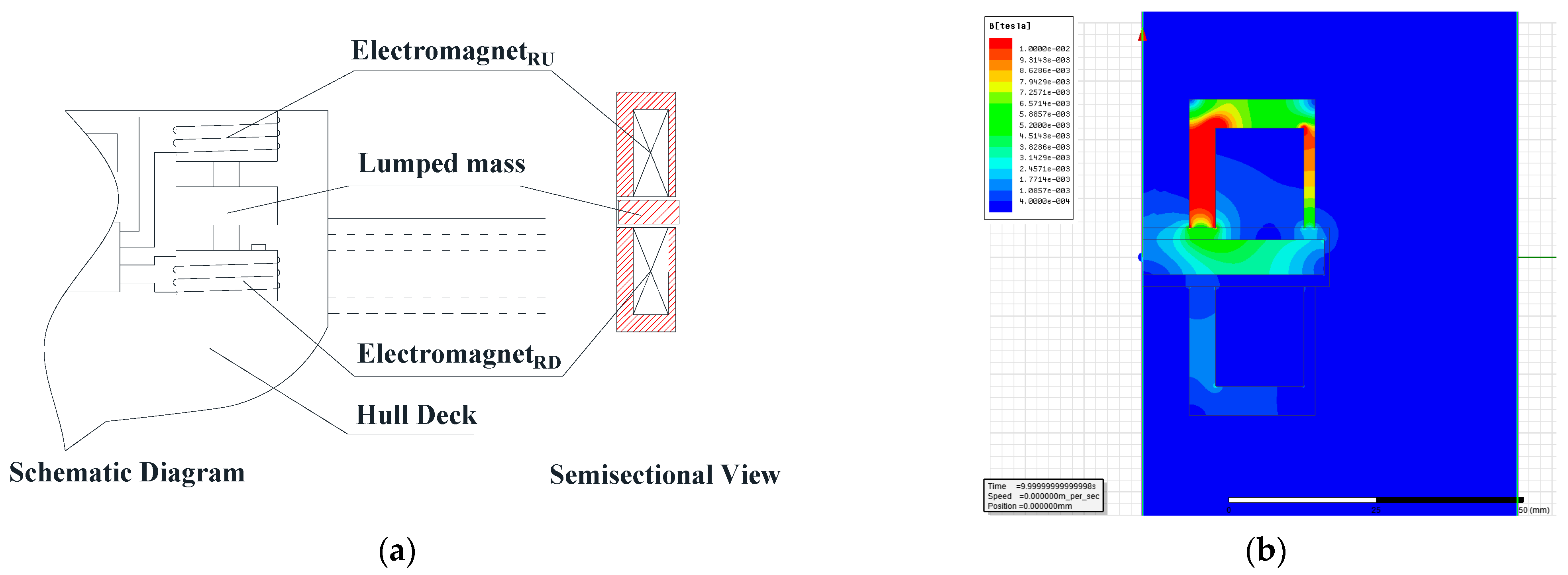

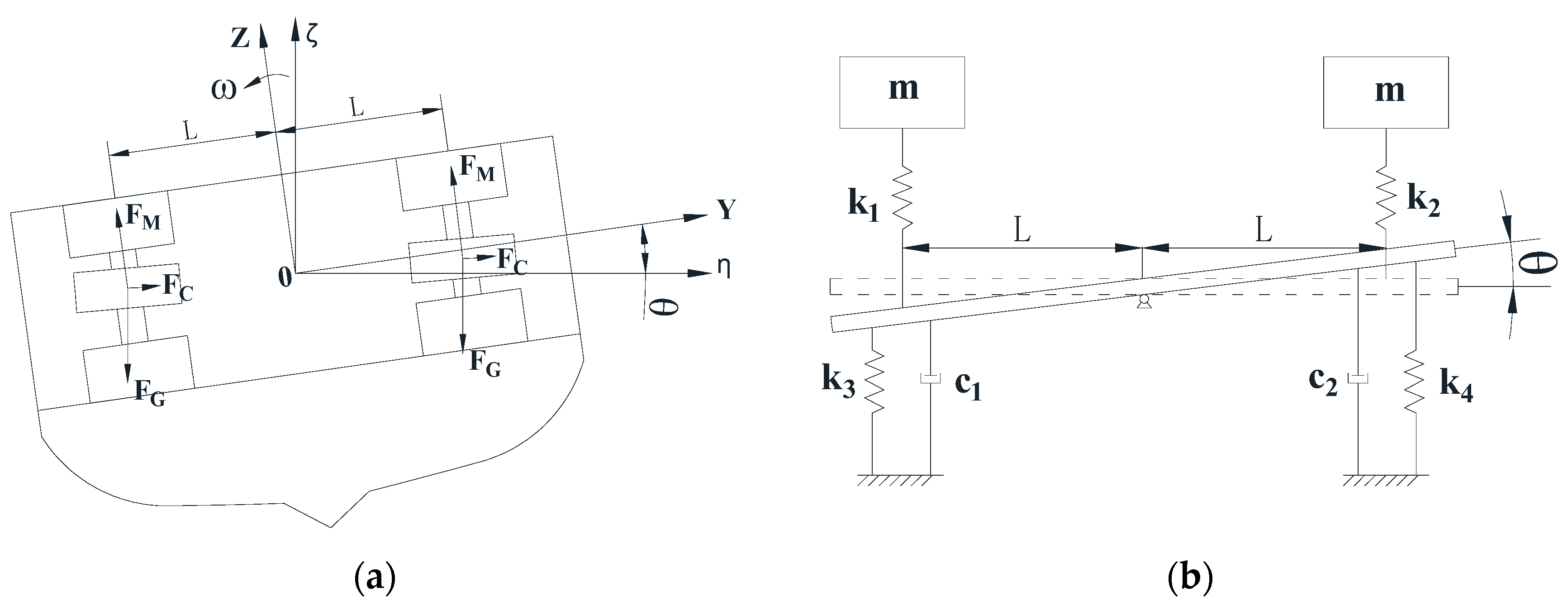
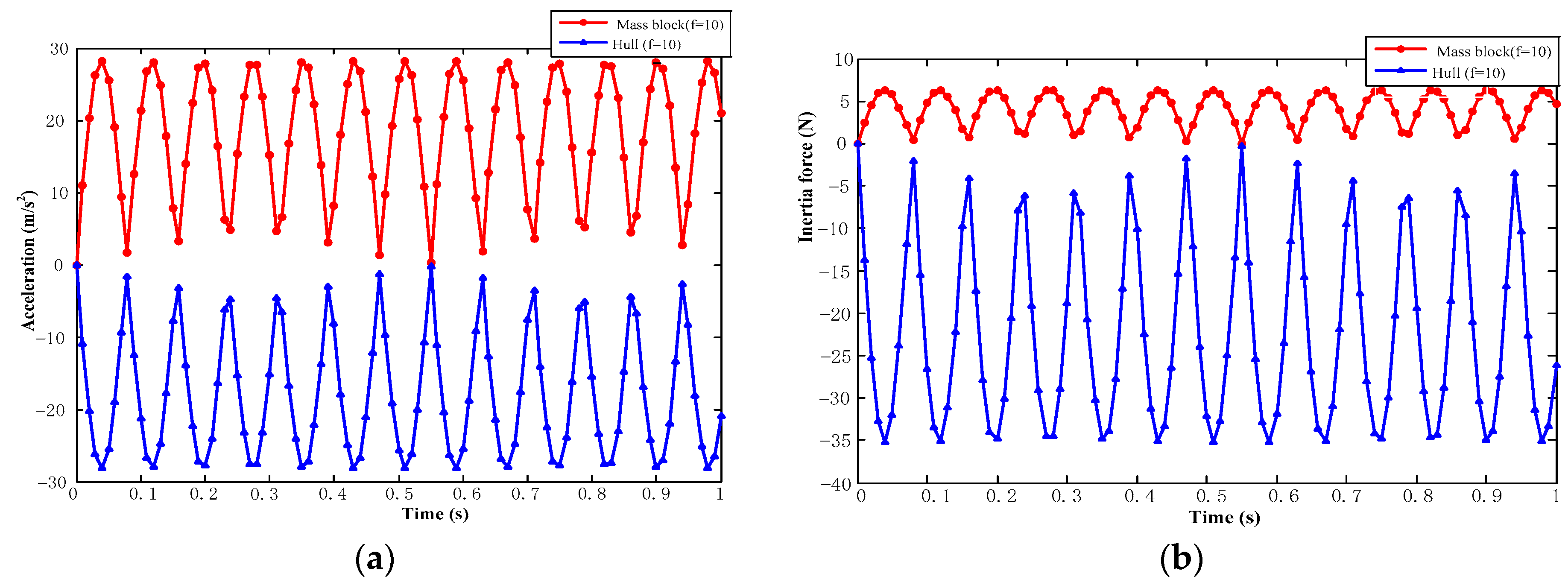
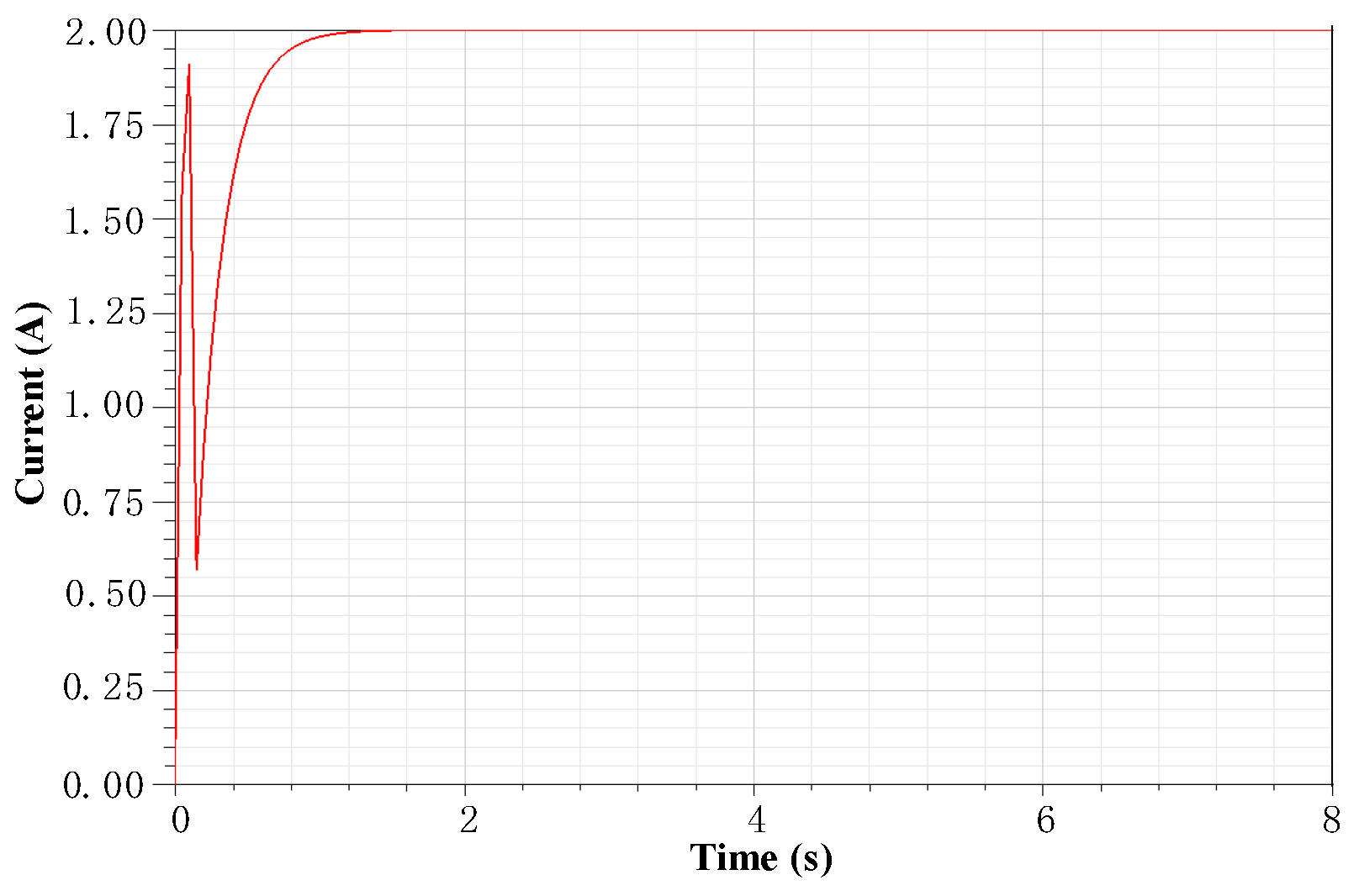
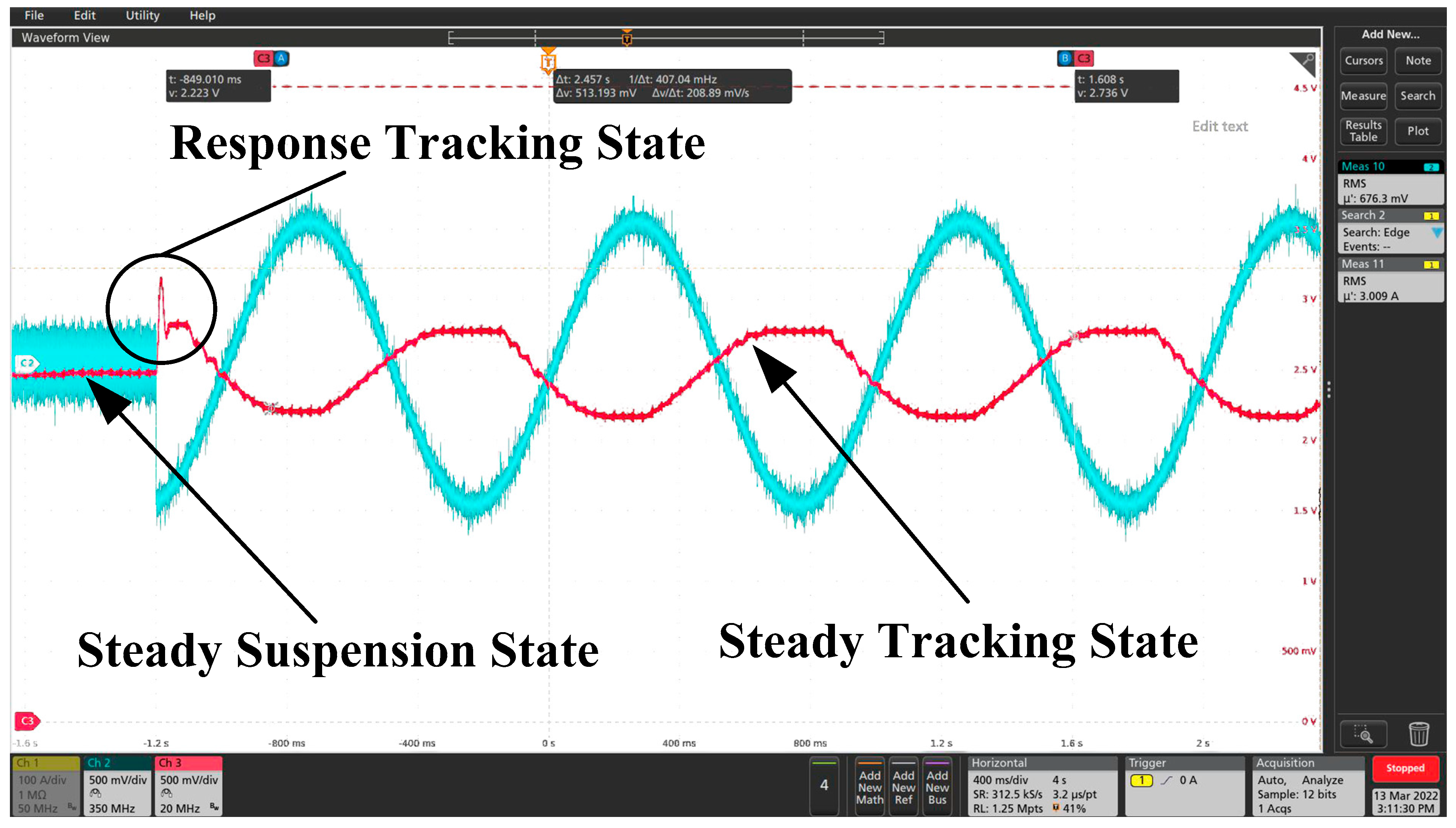
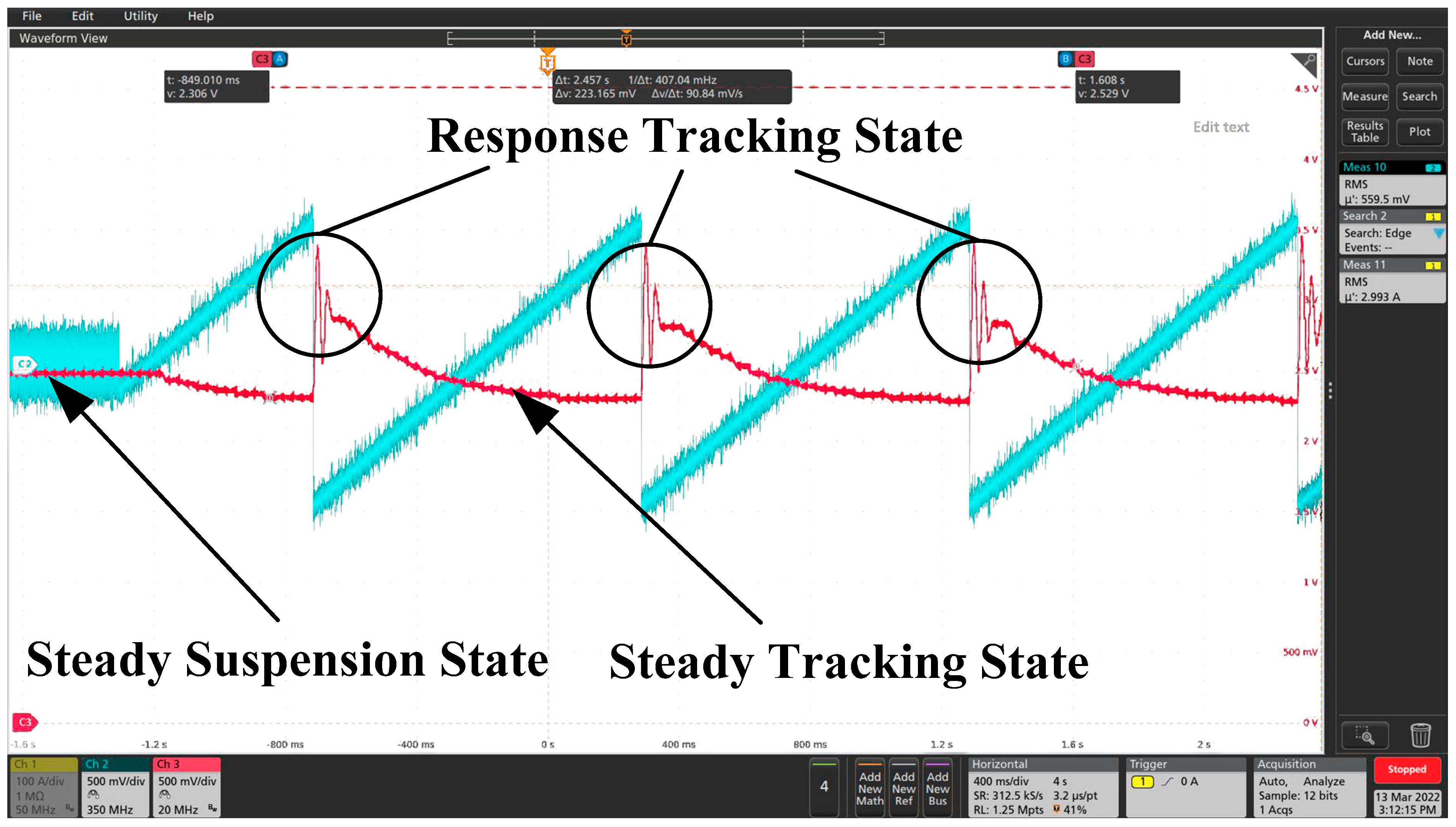

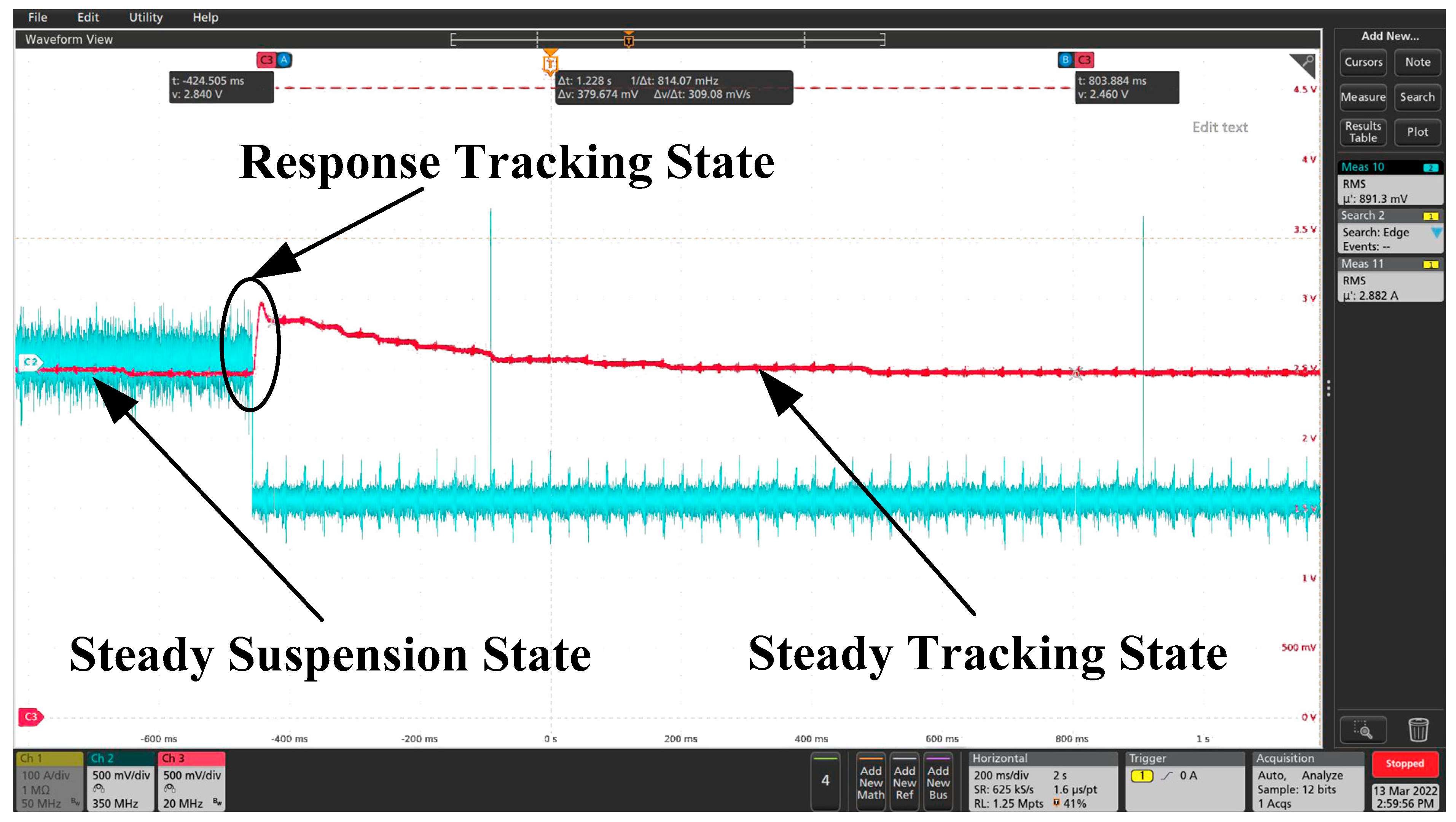


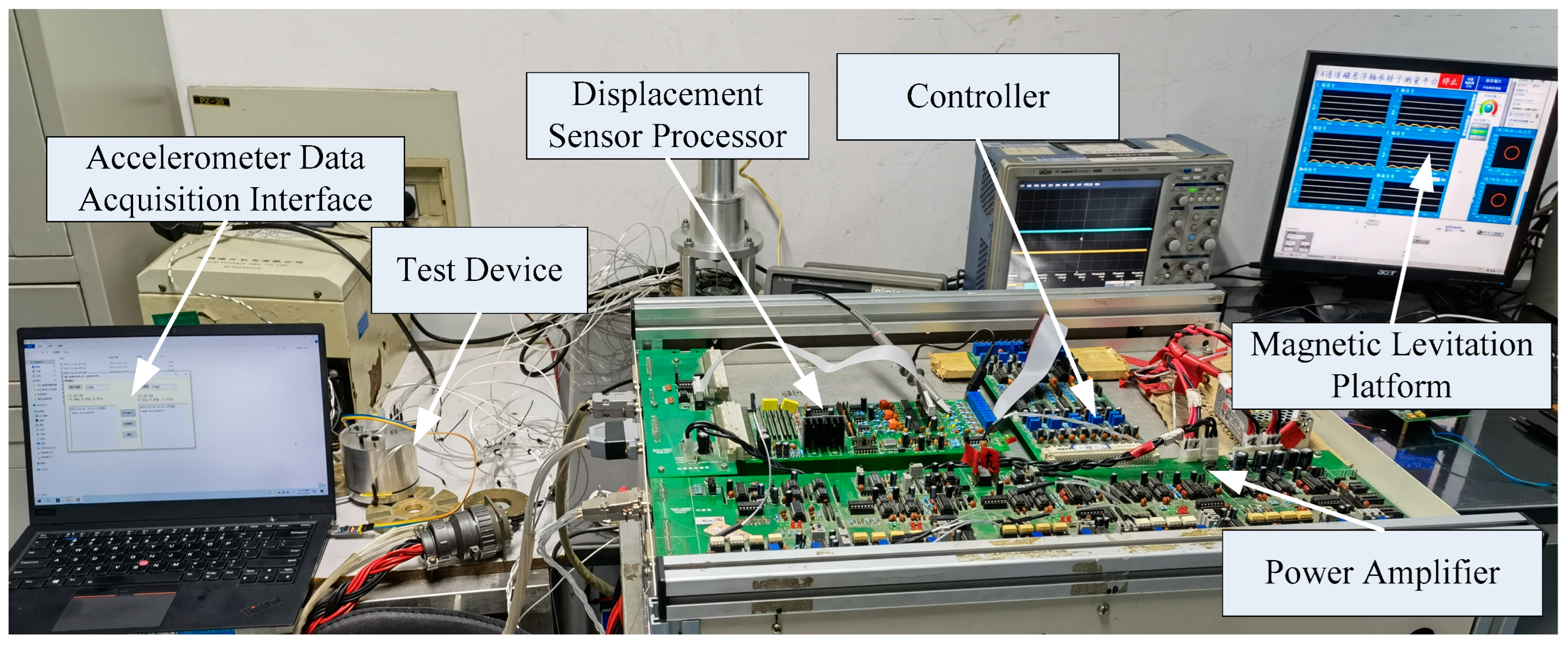
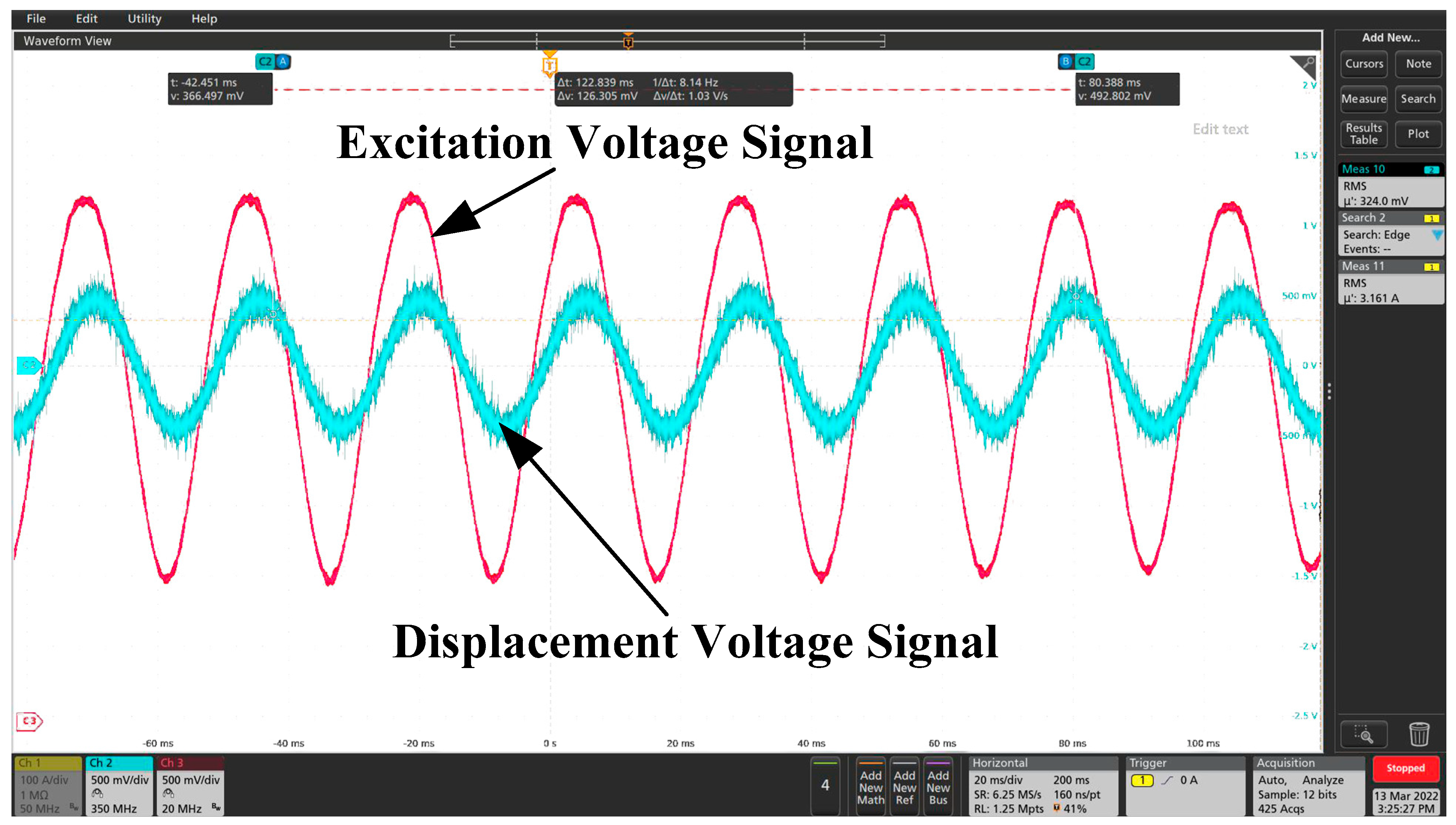
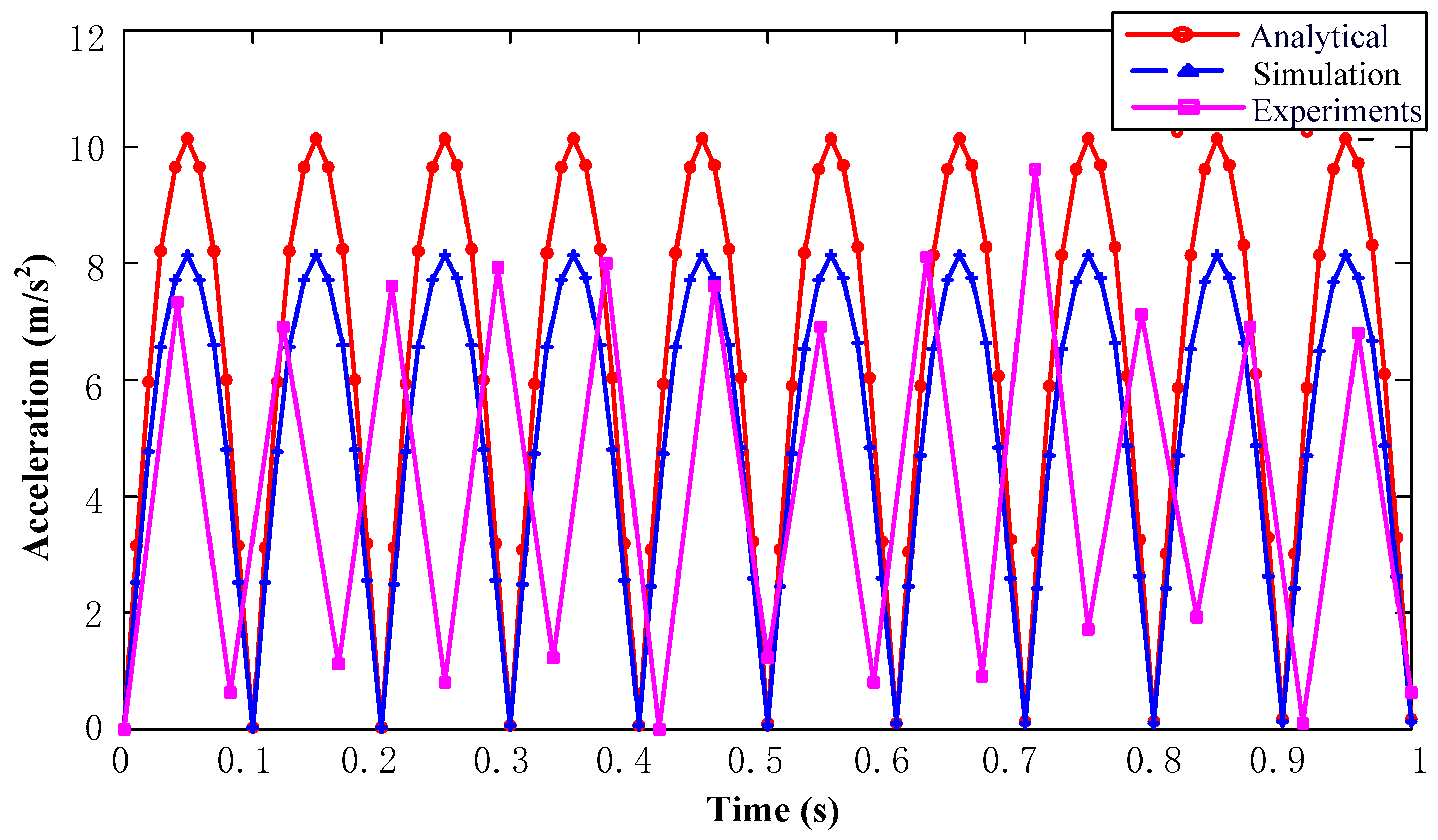
| Parameter | Value |
|---|---|
| Cross-sectional area of electromagnet core | 290 |
| Air permeability | |
| Number of turns of electromagnetic winding N | 138 |
| Diameter of enameled wire mm2 | 1 |
| Electromagnetic winding inductance L/mH | 2.49 |
| Air gap | 1.5 |
| Mass of inertia anti-rolling mass block | 225 |
| Base mass | 1250 |
| Acceleration sensor | JY61 |
| Displacement sensor | Author’s own design |
| Hull Acceleration | Mass Block Acceleration | ||||
|---|---|---|---|---|---|
| X-Axis | Y-Axis | Z-Axis | X-Axis | Y-Axis | Z-Axis |
| −0.03 g | −0.05 g | −0.04 g | −0.11 g | 0.06 g | 0.56 g |
| −0.04 g | −0.01 g | −0.05 g | −0.10 g | −0.19 g | 0.61 g |
| −0.01 g | 0.00 g | −0.07 g | 0.09 g | 0.15 g | 0.25 g |
| −0.01 g | 0.01 g | −0.02 g | 0.10 g | −0.04 g | 0.18 g |
| 0.00 g | 0.02 g | −0.02 g | −0.10 g | 0.06 g | 0.08 g |
| 0.02 g | 0.06 g | −0.03 g | 0.05 g | 0.09 g | 0.39 g |
| −0.04 g | −0.03 g | −0.13 g | 0.04 g | −0.83 g | 0.98 g |
| −0.02 g | 0.05 g | −0.04 g | 0.05 g | 0.03 g | 0.13 g |
| −0.08 g | −0.01 g | −0.01 g | 0.09 g | 0.04 g | 0.16 g |
| −0.08 g | 0.00 g | −0.01 g | 0.12 g | 0.14 g | 0.05 g |
| −0.03 g | 0.05 g | −0.06 g | 0.19 g | −0.03 g | 0.53 g |
| −0.05 g | 0.00 g | −0.02 g | −0.01 g | 0.16 g | 0.63 g |
| −0.10 g | −0.04 g | −0.09 g | 0.05 g | −0.01 g | 1.05 g |
| −0.04 g | 0.03 g | −0.01 g | −0.22 g | 0.02 g | 0.16 g |
| −0.06 g | 0.03 g | −0.01 g | −0.23 g | 0.04 g | 0.30 g |
| −0.01 g | 0.07 g | −0.03 g | 0.05 g | 0.07 g | 0.28 g |
Publisher’s Note: MDPI stays neutral with regard to jurisdictional claims in published maps and institutional affiliations. |
© 2022 by the authors. Licensee MDPI, Basel, Switzerland. This article is an open access article distributed under the terms and conditions of the Creative Commons Attribution (CC BY) license (https://creativecommons.org/licenses/by/4.0/).
Share and Cite
Gao, S.; Xu, L.; Jin, C. Performance Analysis of Acceleration and Inertial Force of Electromagnetic Suspension Inertial Stabilizer. Appl. Sci. 2022, 12, 5304. https://doi.org/10.3390/app12115304
Gao S, Xu L, Jin C. Performance Analysis of Acceleration and Inertial Force of Electromagnetic Suspension Inertial Stabilizer. Applied Sciences. 2022; 12(11):5304. https://doi.org/10.3390/app12115304
Chicago/Turabian StyleGao, Sumei, Longxiang Xu, and Chaowu Jin. 2022. "Performance Analysis of Acceleration and Inertial Force of Electromagnetic Suspension Inertial Stabilizer" Applied Sciences 12, no. 11: 5304. https://doi.org/10.3390/app12115304
APA StyleGao, S., Xu, L., & Jin, C. (2022). Performance Analysis of Acceleration and Inertial Force of Electromagnetic Suspension Inertial Stabilizer. Applied Sciences, 12(11), 5304. https://doi.org/10.3390/app12115304






